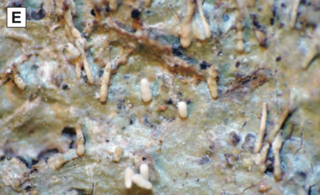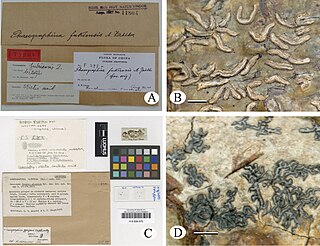
The Graphidaceae are a family of lichen-forming fungi in the order Graphidales. The family contains nearly a hundred genera and more than 2000 species. Although the family has a cosmopolitan distribution, most Graphidaceae species occur in tropical regions, and typically grow on bark.

Acanthotrema is a genus of lichens in the family Graphidaceae. The genus was circumscribed by German lichenologist Andreas Frisch in 2006, with Acanthotrema brasilianum assigned as the type species. Acanthotrema species are commonly found in rainforests ranging from lowland to montane environments.

Thelotrema is a genus of lichen-forming fungi in the family Graphidaceae, the family to which all taxa in the former Thelotremataceae now belong.
Wirthiotrema is a genus of lichen-forming fungi in the family Graphidaceae. The genus was circumscribed in 2010 by Eimy Rivas Plata, Klaus Kalb, Andreas Frisch, and H. Thorsten Lumbsch, with Wirthiotrema glaucopallens assigned as the type species. Wirthiotrema contains species that were formerly considered part of the Thelotrema glaucopallens species group. The genus name honours lichenologist Volkmar Wirth, "for his numerous outstanding contributions to lichenology".
Halegrapha is a genus of lichen-forming fungi in the family Graphidaceae. It has nine species. The genus was circumscribed in 2011 by Eimy Rivas Plata and Robert Lücking, with Halegrapha chimaera assigned as the type species. The generic name honors American lichenologist Mason Hale.
Rhabdodiscus is a genus of script lichens in the family Graphidaceae. It has 36 species.
Cruentotrema is a genus of corticolous (bark-dwelling) lichens in the family Graphidaceae. It has seven species.

Graphidales is an order of lichen-forming fungi in the class Lecanoromycetes. It contains 6 families, about 81 genera and about 2,228 species. Family Graphidaceae are the largest crustose family within Graphidales order comprising more than 2000 species, which are widely distributed in tropical and subtropical regions of the world.
Clandestinotrema is a genus of lichen-forming fungi in the family Graphidaceae. It has 17 species. They typically inhabit montane and cloud forest at higher elevations in the tropics.
Topeliopsis acutispora is a species of crustose lichen in the family Graphidaceae. It is found in New South Wales and southern Queensland (Australia), where it grows on bryophytes.
Ampliotrema sorediatum, a corticolous lichen, is a species in the family Graphidaceae. It was discovered in the tropical lowland rainforest of Peru. The species epithet sorediatum refers to the unusual sorediate thallus, which distinguishes this species from its closest relative, Ampliotrema lepadinoides. The lichen was described as a new species in 2008 by lichenologists Eimy Rivas Plata and Robert Lücking.
Redonographa is a genus of lichen-forming fungi in the monogeneric family Redonographaceae. It has five species.
Austrotrema is a genus of lichen-forming fungi in the family Graphidaceae. It is primarily found in the Australian-Southeast Asian region. The genus is characterized by small, pore-like apothecia with a double margin, faintly amyloid ascospores, and stictic acid chemistry. Austrotrema species grow on tree bark and have a continuous thallus with a cortex that is prosoplectenchymatous–featuring densely packed, filamentous fungal hyphae that run parallel to the surface of the lichen, creating a compact and firm texture. The genus is closely related to Thelotrema and Leucodecton, but can be distinguished from them based on molecular phylogenetic data, specific morphological traits, and its secondary chemistry. Currently, Austrotrema comprises three species.
Sanguinotrema is a single-species fungal genus in the family Graphidaceae, and subfamily Graphidoideae. It contains the species Sanguinotrema wightii, a mostly corticolous (bark-dwelling), crustose lichen. This species has a pantropical distribution.
Gintarasia is a genus of lichen-forming fungi in the family Graphidaceae. It has seven species, all of which are found in Australia. Gintarasia species are corticolous (bark-dwelling), crustose lichens with a thelotremoid form.
Acanthotrema frischii is a species of corticolous (bark-dwelling) lichen in the family Graphidaceae. Found in the East Province of Cameroon, A. frischii has a smooth, olive-green thallus, and its broadly oval, glass-like ascospores. Although initially believed to represent Acanthotrema brasilianum, a Neotropical species, it was identified as a distinct species due to differences in ascospore structure.
Compositrema is a genus of lichen-forming fungi in the family Graphidaceae. It has four species. The genus was circumscribed in 2012 by lichenologists Eimy Rivas Plata, Robert Lücking, and Helge Thorsten Lumbsch, with C. cerebriforme assigned as the type species. The genus is distinguished by its unique, composite pseudostromatic ascomata, which sets it apart from the otherwise similar genus Stegobolus.
Compositrema cerebriforme is a species of corticolous (bark-dwelling) lichen in the family Graphidaceae. It is notable for its distinct structure and resemblance to the shape of a brain. It was discovered in the greenery of Venezuela's Henri Pittier National Park, and described as a new species in 2012.
Ocellularia vizcayensis is a rare species of corticolous (bark-dwelling) lichen in the family Graphidaceae. It is known from a single collection made in Luzon, Philippines. The lichen thallus is a white, irregularly structured, areolate surface with a layer that includes a photosynthetic partner, both containing large calcium oxalate crystals. Its fruiting bodies are either embedded or protruding, round, with very narrow openings, and contain large, oblong, colorless spores that turn violet-blue when stained with iodine.
Nitidochapsa is a genus of lichen-forming fungi in the family Graphidaceae. It has five species of corticolous (bark-dwelling), crustose lichens.



